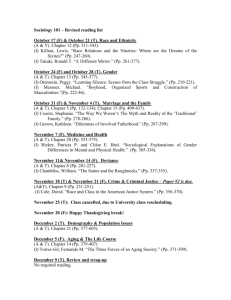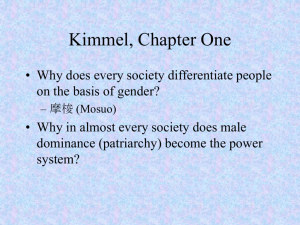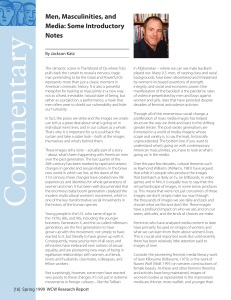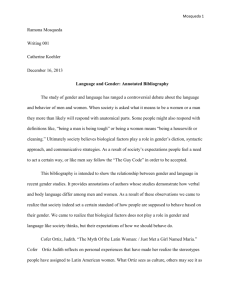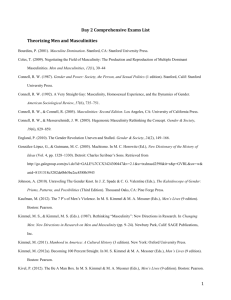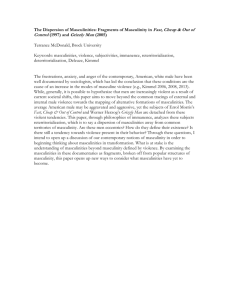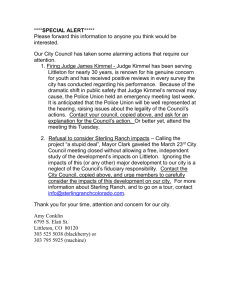Week 14, 4/28 - Brandeis University
advertisement
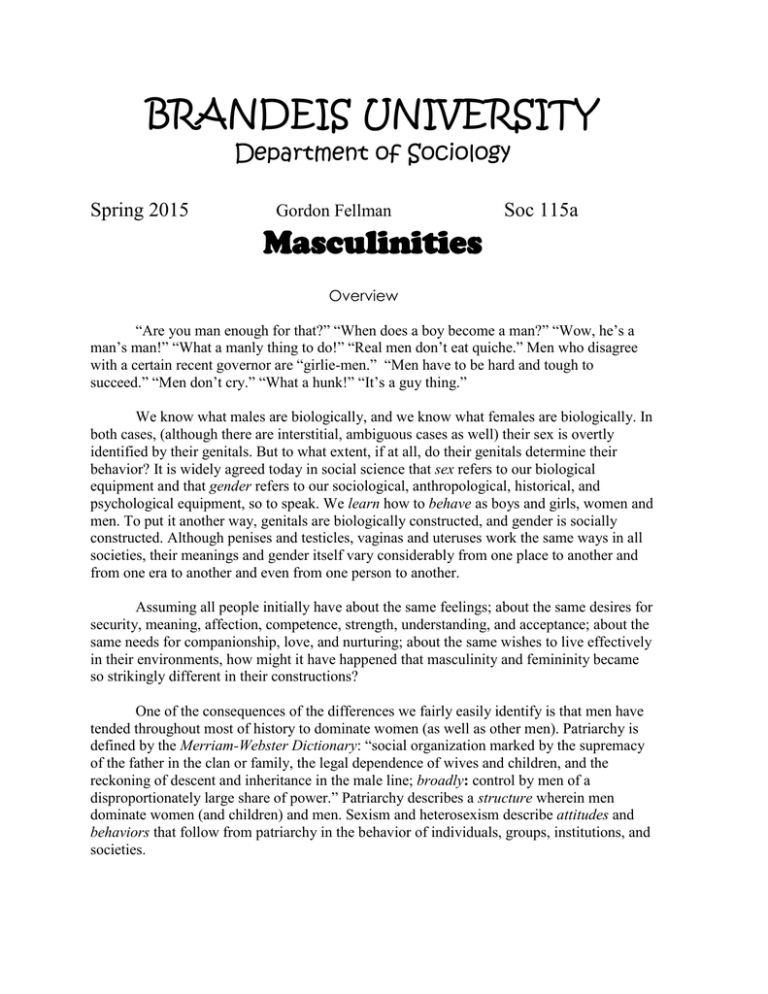
BRANDEIS UNIVERSITY Department of Sociology Spring 2015 Gordon Fellman Soc 115a Masculinities Overview “Are you man enough for that?” “When does a boy become a man?” “Wow, he’s a man’s man!” “What a manly thing to do!” “Real men don’t eat quiche.” Men who disagree with a certain recent governor are “girlie-men.” “Men have to be hard and tough to succeed.” “Men don’t cry.” “What a hunk!” “It’s a guy thing.” We know what males are biologically, and we know what females are biologically. In both cases, (although there are interstitial, ambiguous cases as well) their sex is overtly identified by their genitals. But to what extent, if at all, do their genitals determine their behavior? It is widely agreed today in social science that sex refers to our biological equipment and that gender refers to our sociological, anthropological, historical, and psychological equipment, so to speak. We learn how to behave as boys and girls, women and men. To put it another way, genitals are biologically constructed, and gender is socially constructed. Although penises and testicles, vaginas and uteruses work the same ways in all societies, their meanings and gender itself vary considerably from one place to another and from one era to another and even from one person to another. Assuming all people initially have about the same feelings; about the same desires for security, meaning, affection, competence, strength, understanding, and acceptance; about the same needs for companionship, love, and nurturing; about the same wishes to live effectively in their environments, how might it have happened that masculinity and femininity became so strikingly different in their constructions? One of the consequences of the differences we fairly easily identify is that men have tended throughout most of history to dominate women (as well as other men). Patriarchy is defined by the Merriam-Webster Dictionary: “social organization marked by the supremacy of the father in the clan or family, the legal dependence of wives and children, and the reckoning of descent and inheritance in the male line; broadly: control by men of a disproportionately large share of power.” Patriarchy describes a structure wherein men dominate women (and children) and men. Sexism and heterosexism describe attitudes and behaviors that follow from patriarchy in the behavior of individuals, groups, institutions, and societies. While it is not difficult to understand that gender is socially constructed, that does not mean that there is a clear or single set of behaviors that define one as a man in this or any other society. “Masculinity” is a general and vague term. Upon close inspection, there are many “masculinities.” Athletes and scholars, businessmen and clergy, poets and workers, gay men and straight and bi and transgendered and pansexual people, members of one ethnic or race or social class culture or another do not exhibit the same ways of being what any of them might call masculine. Nor do they all think of masculinity in the same way. Nor do women. Largely as a consequence of many years of the women’s and the gay, lesbian, bisexual, queer, and transgender movements, it is increasingly common for men as well as women to inquire into what it means to be a man and how one might reassess what one has taken for granted about what it is to be a man. This course is meant to be an entrée into some of the discourse on this topic and is intended to help students of whatever gender and sexual orientations, to find their way to evolve ever more sophisticated ways of understanding gender and themselves and acting on those understandings. Format The course will meet Tuesdays and Fridays 9:30-10:50. It will be organized in seminar fashion, with minimal lecturing by the instructor and maximal participation by all class members. The evening of the third day of class, we will watch a film together and discuss it in terms of the issues of the course and concepts and concerns we bring to the course. As we read each week, two or three students will be asked to organize the discussion; start it off with a few questions, insights, or problems; and facilitate it. It will be crucial that everyone be up on the reading, so as to make discussions as lively and full as possible. Presenters will be asked to meet ahead of their presentation with the instructor and/or a TA in terms of offering a challenging, stimulating time in class. During about half the class one day a week, most likely on Fridays, we will break up into several discussion sections to explore course issues further than we can in the larger class setting. A TA will lead each of these groups. We intend to open each class with something typically or atypically masculine in the form of a brief TV ad or scene from a program or other presentation or a poem or print ad or some other item with which to have a brief discussion. We will from the start pair up so that each pair will be responsible for one or possibly two such presentations during the semester. It would be most efficient if that pair also took charge of organizing our attention to the reading for that class. Background for the course The course assumes serious interest in its topic and does not assume background in the subject, sociology, or social psychology. If the course frustrates you, bores you, and/or 2 disappoints you in any way that detracts from your learning, PLEASE take up such discontents with the professor and/orTAs as seems appropriate. We emphasize understanding and working with the concepts and readings of the course and on thinking creatively with them. It is assumed that real learning involves risk and re-thinking assumptions and familiar paradigms (with no preordained or “right” outcome of this process) as well as learning new concepts and new information. We will pay attention to such matters as involvement, keeping up with the reading, attendance, and participation. We will honor hesitations, fears, bewilderment as it unfolds. The premium is on honesty of one’s reactions—emotional as well as intellectual— to all parts of the course and to fellow students, TAs, and professor. Latte Postings In addition to syllabus assignments, the instructor will post on our course LATTE page from time to time news and other items germane to our course. Most of these will be fairly brief, and students are asked to keep up with them, particularly those that might be marked with “to discuss in class” or something like that. Cooperative Learning Cooperative learning. It is important that we create and feel a safe space in our classroom. There will be a diversity of views among us that we are to hear, honor, and explore together. It is essential to listen closely to others and not spend time formulating what you want to say next or dissing the speaker’s remarks in an imagined conversation with him or her. We will try to create mutuality within our classroom and discussion sections. Toward this end, students will be asked to listen fully to all parts of all discussions. The instructor and the TAS will do their best to help facilitate this way of working. We will also ask you to do some of your work together in pairs as well as in discussion sections. Cooperative learning includes listening to everything going on in class. To that end, students will be asked to use laptops and smart phones ONLY for course related work. Doing Facebook or solitaire or google searches or e-mail, etc. on computers in class will be considered a violation of the assumption that we are all studying together and an insult to those sharing that assumption as well as to the person taking attention away from the substance of the course. Response papers As there will be no final paper on the course materials, response papers will be the means for professor and TA to know your responses to and relationships with the readings, films, and class discussions. They will be done in pairs, rather than singly. We will discuss this method well before the first response paper is due. We want in this course to have a conversation among all of us—students, TAs, and professor. One way to do this is through written responses to readings and other course materials. Toward that end, we ask you to work together in groups of two or three (not to be 3 rigid about this, occasionally four work together well) in writing short response papers every few weeks. Here is what we have in mind: 1. It is well to learn to write succinctly. Practice getting to the point quickly and saying what you mean. The papers should be held to 3-4 pages, although if you really get caught up in something and wish to do so, negotiate for more. Suggested foci: 1) What is new to you in this reading? What do you make of it? What problems do you have with it? 2) What continuities do you see with previous weeks’ readings? 3) What contradictions do you see in the reading, and/or how does it contradict prior reading? What do you make of this? 3) What insights do you gain from this reading and its location in the course? What other connections do you make with materials outside the course? 2. If you find the reading difficult, summarizing it to get a hold of it can be useful, but do not make the paper a book report. The point of this kind of response paper is to ask if your interpretation of what the author said makes sense to the reader. Do not restate what the author said in her or his terms. Quotations may be used sparely to illustrate a point or ask a question, and we urge you to work directly from the texts, but do not just repeat the author without using your own words. 3. All reading is interpretation. We never focus on it all, and we never comprehend it all. What matters is that the reader grapple with the text to understand it as fully as possible, to make sense of it, and to offer critical interpretations of it. 4. Please focus on your own questions about the reading, your critical reactions to it, hesitations, reservations, etc. And most important: your own insights about it. Strive to make connections within the reading that the author may not have made. Strive to connect the reading with other reading, with central ideas and issues as they develop in the course, with your own understanding of the world, your reactions to what you see in society and your own life. 5. The premium in these papers is on showing the reader that you are grappling with the course materials, have opened yourself up to the possibility that there is something in them for you, and can think creatively with what we are studying. The premium also is on integrating what may seem like disparate materials, and struggling to make sense of them in your reality as a citizen and as a thinking, feeling, viable actor in society. 6. In the response papers, you may work with class discussions, films, professor’s and TAs’ views, world events, whatever, but always in the context of the readings. I.e., no riffing from the top of your head on interesting things that may be relevant to the course. That is, of course, easy to do in sociology classes but is not helpful. We are looking for real struggle with reading and other course materials. Journals Students are asked to keep a journal of one to two pages per week of personal reactions to masculinities issues in readings, films, other class materials, ads, popular culture, whatever. 4 Strive for seeing and feeling insights and connections you had not noticed or made before. You will be asked to turn these in with response papers. Final Project In place of a final exam, each student will be required to conduct an inquiry/field research project that will involve one or more of these methods: interviews, field observations, and participant observation, on the topic, What is masculinity? These inquiries can be done individually or in groups. We will present our findings to each other, in the class, near the end of the semester. The written report on the research will be due 4/28 for seniors and 5/1 for everyone else. Back up all work Please word process all written work. BE SURE TO BACK UP ALL WORK AS YOU GO ALONG; losing work on the computer will not be accepted as an excuse for anything. Grading standards A—mastery of readings, concepts, and exercises; full participation, engagement, risktaking, and growth; grappling with the course and coming to your own insights about its issues, its implications, its relation to yourself; involvement in class and in discussion group. B—clear understanding of course materials and conscientious participation but little evidence of risk-taking and growth or grappling with the course toward one's own insights; slight involvement in class and discussion group. C—fuzzy, incomplete, lethargic relationship with course materials, minimal involvement of self in course, little risk-taking and growth, no insights of one’s own. D—same as C but moreso. E—trying to wing it by leaning too much on others’ understanding, not writing journal entries fully germane to the readings and central concepts of the course, erratic participation, not completing all course requirements, etc. Required Readings Books Belkin, Aaron, Bring Me Men, London: Hurst, 2012 Ducat, Steven, The Wimp Factor, Boston: Beacon Press, 2004 Johnson, Allan, The Gender Knot, Temple University Press, 2005 Kimmel, Michael Guyland, New York: HarperCollins, 2008 Kimmel, Michael, The History of Men: Essays in the History of American and British Masculinities, Albany: SUNY Press, 2005 5 Kimmel, Michael and Michael Messner, Men’s Lives,9th Edition. Boston: Allyn & Bacon, 2003 Pascoe, C.J, Dude, You’re a Fag, U. Cal. Press, 2007 Reading Schedule Chapters and articles from non-required books will be available on LATTE. Chapters in Men’s Lives are from the 9th edition. Many but not all of the assigned articles are also be found in previous editions. Readings are to be completed before the date listed, and discussed on that date in the classroom Introduction Week 1, 1/13: What is masculinity? o Introductions, our own understandings of and definitions of masculinities, discussion of the final project. 1/16: o Preface and Introduction to whichever edition of Kimmel and Messner you are using o Kimmel, Guyland, Preface and chs. 1-4 Deconstructing gender, conceptualizing masculinities Week 2, 1/20: Gender o Butler, Gender Trouble, Part One, (LATTE) o Evening: 7-9:00 viewing and brief discussion of feature film Billy Elliot, Pearlman Lounge 1/23: Continue discussion of film. Read also o Gender Knot, Johnson. Part I. Week 3, 1/27: Masculinities and Hegemonic Masculinity. o Kimmel and Messner, Men’s Lives, articles in Part One o o o o Article 1, Martha McCaughey, “Caveman Masculinity: Finding at Ethnicity in Evolutionary Science” Article 2, Barry Deutsch, “The Male Privilege Checklist” Article 3, Yen Le Espiritu, “All Men Are Not Created Equal: Asian Men in US History” Article 4, Alfredo Mirande, “’Macho”: Contemporary Conceptions” 1/30: Connell, Masculinities. Part I (LATTE) Discuss final project/research paper assignment. FIRST RESPONSE PAPER IS DUE 2/3. WHAT ISSUES ARE RAISED IN THE COURSE SO FAR? WHAT HAVE YOU LEARNED SO FAR? WHAT PROBLEMS DO YOU 6 HAVE WITH THE COURSE MATERIALS (BOOKS, ARTICLES, CLASSES, FILMS, ETC.) SO FAR? Hegemonic masculinity, considerations Week 4, 2/3: The social psychological angle o Ducat, The Wimp Factor, Chs. 1-3 2/6: Ducat, Wimp Factor, ch. 4-5 Week 5, 2/10: Historical perspectives o Connell, Masculinities, Ch. 8, “The History of Masculinity” o Kellner, Guys and Guns Amok, ch. 3, “Constructing Male Identities and the Spectacle of Terror” (LATTE) o Ducat, Wimp Factor, ch.6 2/13: Kimmel, History of Men o o o Introduction ch. 1, “Invisible Masculinity “ ch. 2, “Born to Run: Fantasies of Male Escape from Rip Van Winkle and Robert Bly” o Johnson, Gender Knot, Part II, Sustaining Illusions, Barriers to Change Research proposal is due this week. VACATION 2/16-2/22 Work, Sport, and Race Week 6, 2/24: Work and men o Kimmel, History of Men o o ch. 3, “Consuming Manhood: The Feminization of American Culture and the Recreation of the Male Body, 1832-1920 Kimmel, Guyland, chs. 5-6. 2/27: o Kimmel, Guyland, chs. 7-8 Discuss field projects. Week 7, 3/3: Sports and violence o Kimmell and Messner, Men’s Lives o o o Article 42, Nick Pappas, Patrick C. McHenry, and Beth Skillen Catlett, “Athlete Aggression on the Rink and off the Ice: Athlete Violence and Aggression in Hockey and Interpersonal Relationships” Article 43, James Gilligan, “Culture, Gender, and Violence: ‘We Are Not Women’” Article 44, Tim Beneke, “Men on Rape” 7 Article 45, Cynthia Enloe, “Wielding Masculinity inside Abu Ghraib: Making Feminist Sense of an American Military Scandal” o 3/6: o Derek A. Kreager, “Unnecessary Roughness: School Sports, Peer Networks, and Male Adolescent Violence,” (American Sociological Review, October 2007) (LATTE) o Kimmel, History of Men o Ch. 4, “Baseball and the Reconstruction of American Masculinity 18321920” o SECOND RESPONSE PAPER DUE 3/10. WHAT HAVE YOU LEARNED OF SIGNIFICANCE SO FAR ABOUT THE SOCIAL PSYCHOLOGY OF MASCULINITY AND MASCULINISM? THE HISTORY OF MASCULINITY? HOW WORK, SPORT, AND RACE INTERSECT? WHAT PROBLEMS HAVE YOU WITH ANY OF THIS? Week 8, 3/10: Racialized masculinities Kimmell and Messner, Men’s Lives, Chs. 2, 44, and 49. 6th edition but not 7th or 8th. All four of these will be on LATTE o o o 2. Marable, “The Black Male: Searching Beyond Stereotypes” 44. Cantú, “A Place Called Home: A Queer Political Economy: Mexican Immigrant Men's Family Experiences” 49. Fung, “Looking for My Penis: The Eroticized Asian in Gay Video Porn” 3/13: o Don Sabo, in Sabo, et al, Prison Masculinities, “Doing Time, Doing Masculinity: Sports and Prison” (LATTE) o Cynthia Hasbrook and Othello Harris, in Jim McKay, et al, Masculinities, Gender Relations, and Sport. “Wrestling with Gender: Physicality and Masculinities among Inner-city First and Second Graders” (LATTE) Sexualities Week 9, 3/17: Hetero-normative sexuality o Kimmel, Guyland, chs. 9-10 Evening: film, Pearlman Lounge 3/20: o Kimmel and Messner, Men’s Lives o o o Article 22, Steinem, “If Men Could Menstruate” Article 30, Rochlin, “The Heterosexual Questionnaire” Article 29, Messner, “Becoming 100% Straight” Week 10, 3/24: Non-normative sexuality. 8 o Pascoe, Dude, You’re a Fag, Pascoe, chs. 1-3 3/27 Pascoe, chs. 4-6 and Appendix. Relationships and the gender gap Week 11, 3/31: Men in relationships and in families o Guyland, chs. 11-12 o Vacation, 4/3-4/12 Week 12, 4/14 o Bedford and Turner, ch. 6, “Portraits of Paternity: Middle Aged and Elderly Fathers’ Involvement with Adult Children. o Ducat, Wimp Factor, ch. 7 Progress report on field project is due. 4/17 o Kimmel and Messner, Men’s Lives o o o Article 34, Deutsch, “Strategies Men Use to Resist” Article 35, Shelton and John, “Ethnicity, Race, and Difference: A Comparison of White, Black, and Hispanic Men’s Household Labor Time” Article 36, Coltrane, “Fathering: Paradoxes, Contradictions, and Dilemmas” o Bedford and Turner, ch. 7, “Closeness and Affection in FatherSon Relationships” (LATTE) THIRD RESPONSE PAPER, DUE 4/21: WHAT HAVE YOU LEARNED SO FAR IN TERMS OF RACE, SEXUALITY, AND RELATIONSHIPS? WHAT PROBLEMS HAVE YOU WITH ANY OF THIS? Discuss final project progress reports. Week 13, 4/21: Deconstructing the Gender Gap o Johnson, The Gender Knot, Parts II and III 4/24: o Kimmel, History of Men, o Ch. 5, “Men’s Responses to Feminism at the Turn of the Century” Challenging masculinity and the future Week 14, 4/28: o Kimmel and Messner, Men’s Lives o o Article 47, Jackson Katz, “More Than a Few Good Men” Article 48, Mark Anthony Neal, “New Black Man” 9 o o Article 49, Eric Anderson, “’I Used to Think Women Were Weak’: Orthodox Masculinity, Gender Segregation, and Sport” Kimmel, History of Men o Ch 7, “Pro-Feminist Men’s Rhetoric of Support for Women’s Equality” If you are a student with a documented disability on record at Brandeis University and wish to have a reasonable accommodation made for you in this class, please see the instructor immediately. 10
